towing BMW X5 3.0I 2001 Owners Manual
[x] Cancel search | Manufacturer: BMW, Model Year: 2001, Model line: X5 3.0I, Model: BMW X5 3.0I 2001Pages: 223, PDF Size: 2.66 MB
Page 12 of 223
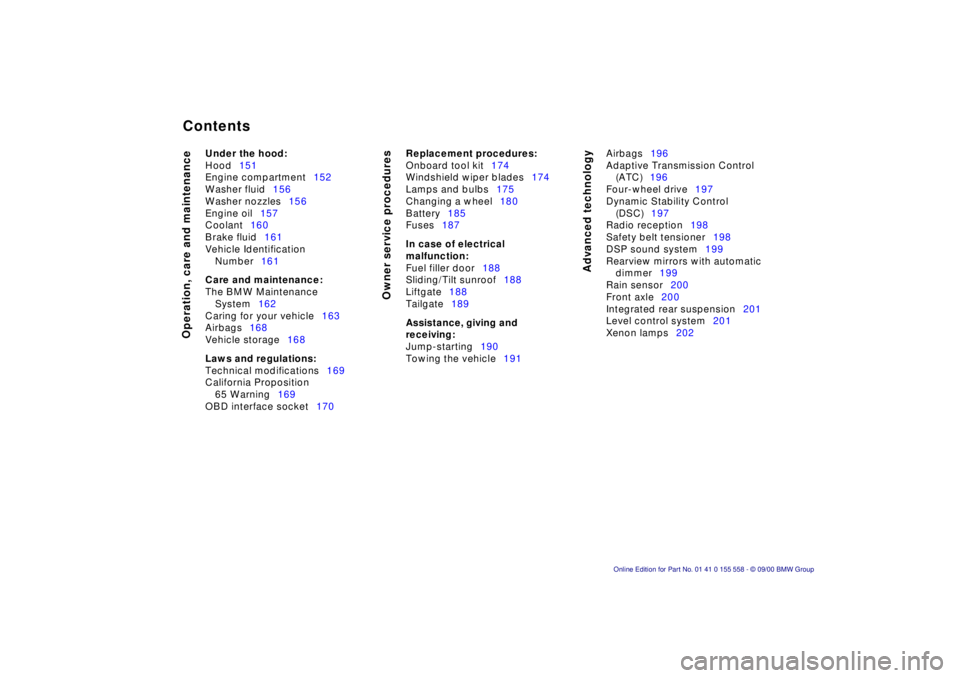
Contents
Operation, care and maintenanceOwner service proceduresAdvanced technology
Under the hood:
Hood 151
Engine compartment 152
Washer fluid 156
Washer nozzles 156
Engine oil 157
Coolant 160
Brake fluid 161
Vehicle Identification Number 161
Care and maintenance:
The BMW Maintenance
System 162
Caring for your vehicle 163
Airbags 168
Vehicle storage 168
Laws and regulations:
Technical modifications 169
California Proposition 65 Warning 169
OBD interface socket 170
Replacement procedures:
Onboard tool kit174
Windshield wiper blades 174
Lamps and bulbs 175
Changing a wheel 180
Battery 185
Fuses 187
In case of electrical
malfunction:
Fuel filler door 188
Sliding/Tilt sunroof 188
Liftgate 188
Tailgate 189
Assistance, giving and
receiving:
Jump-starting 190
Towing the vehicle 191 Airbags
196
Adaptive Transmission Control (ATC) 196
Four-wheel drive 197
Dynamic Stability Control (DSC) 197
Radio reception 198
Safety belt tensioner 198
DSP sound system 199
Rearview mirrors with automatic dimmer 199
Rain sensor 200
Front axle 200
Integrated rear suspension 201
Level control system 201
Xenon lamps 202
Page 70 of 223
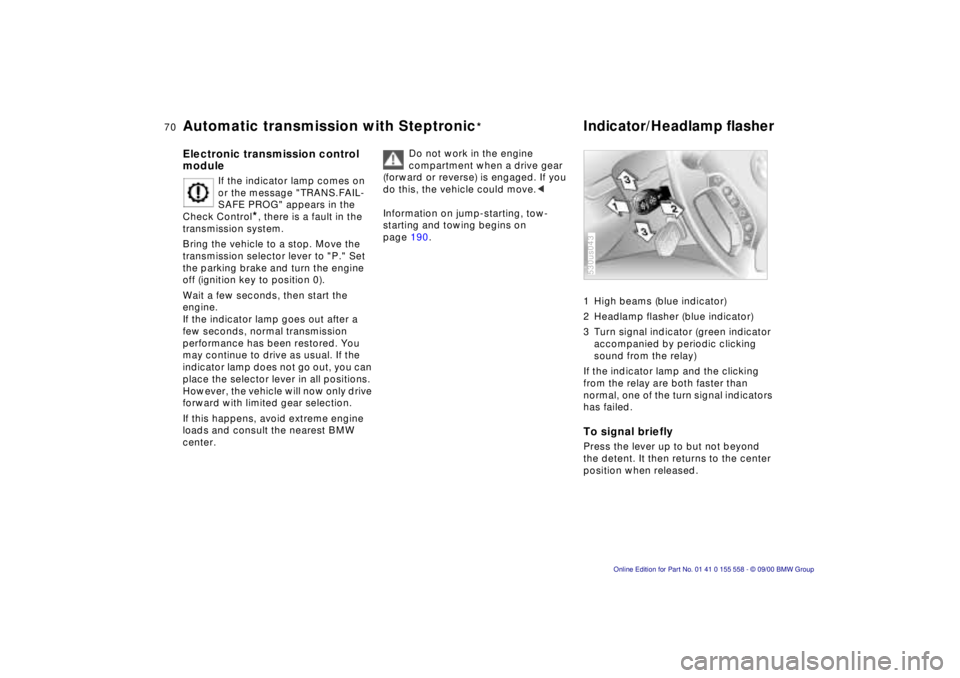
70nAutomatic transmission with Steptronic*Indicator/Headlamp flasher
Electronic transmission control
module
If the indicator lamp comes on
or the message "TRANS.FAIL-
SAFE PROG" appears in the
Check Control
*, there is a fault in the
transmission system.
Bring the vehicle to a stop. Move the
transmission selector lever to "P." Set
the parking brake and turn the engine
off (ignition key to position 0).
Wait a few seconds, then start the
engine.
If the indicator lamp goes out after a
few seconds, normal transmission
performance has been restored. You
may continue to drive as usual. If the
indicator lamp does not go out, you can
place the selector lever in all positions.
However, the vehicle will now only drive
forward with limited gear selection.
If this happens, avoid extreme engine
loads and consult the nearest BMW
center.
Do not work in the engine
compartment when a drive gear
(forward or reverse) is engaged. If you
do this, the vehicle could move. <
Information on jump-starting, tow-
starting and towing begins on
page 190.
1 High beams (blue indicator)
2 Headlamp flasher (blue indicator)
3 Turn signal indicator (green indicator
accompanied by periodic clicking
sound from the relay)
If the indicator lamp and the clicking
from the relay are both faster than
normal, one of the turn signal indicators
has failed.
To signal briefly
Press the lever up to but not beyond
the detent. It then returns to the center
position when released.
530us043
Page 129 of 223
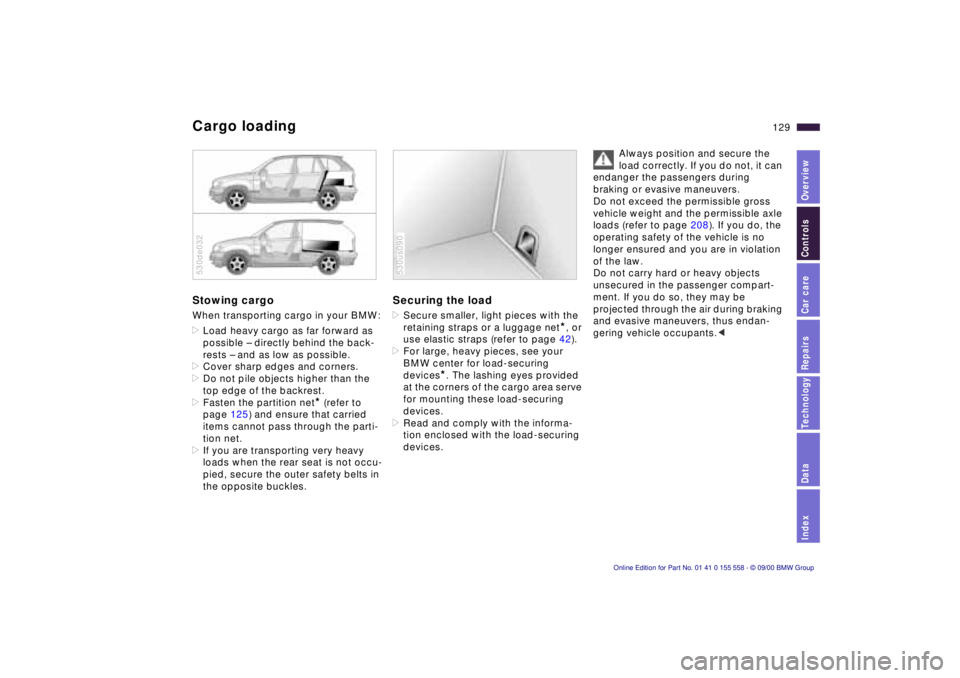
IndexDataTechnologyRepairsCar careControlsOverview
129n
Cargo loadingStowing cargo When transporting cargo in your BMW:
>Load heavy cargo as far forward as
possible – directly behind the back-
rests – and as low as possible.
>Cover sharp edges and corners.
>Do not pile objects higher than the
top edge of the backrest.
>Fasten the partition net
* (refer to
page 125) and ensure that carried
items cannot pass through the parti-
tion net.
>If you are transporting very heavy
loads when the rear seat is not occu-
pied, secure the outer safety belts in
the opposite buckles.
530de032
Securing the load >Secure smaller, light pieces with the
retaining straps or a luggage net
*, or
use elastic straps (refer to page 42).
>For large, heavy pieces, see your
BMW center for load-securing
devices
*. The lashing eyes provided
at the corners of the cargo area serve
for mounting these load-securing
devices.
>Read and comply with the informa-
tion enclosed with the load-securing
devices.
530us090
Always position and secure the
load correctly. If you do not, it can
endanger the passengers during
braking or evasive maneuvers.
Do not exceed the permissible gross
vehicle weight and the permissible axle
loads (refer to page 208). If you do, the
operating safety of the vehicle is no
longer ensured and you are in violation
of the law.
Do not carry hard or heavy objects
unsecured in the passenger compart-
ment. If you do so, they may be
projected through the air during braking
and evasive maneuvers, thus endan-
gering vehicle occupants.<
Page 134 of 223

134n
Break-in proceduresTo ensure that your vehicle provides
maximum economy throughout a long
service life, we request that you
observe the following suggestions: Engine and axle drive Up to 1,200 miles (2,000 km):
Drive at varying engine speeds and
road speeds, but do not exceed
4,500 rpm and the following road
speeds during this initial period:
BMW X5 3.0i: 100 mph (160 km/h)
BMW X5 4.4i: 106 mph (170 km/h)
Obey your local and state maximum
speed limits.
Refrain from using full throttle and avoid
pressing the accelerator beyond the
kickdown point.
Once you have driven 1,200 miles
(2,000 km), engine and vehicle speeds
can gradually be increased.
You should also comply with these
break-in procedures if the engine or
one of the axle drives is replaced later
in the course of the vehicle service life.
TiresDue to technical factors associated
with their manufacture, tires do not
achieve their full traction potential until
an initial break-in period has elapsed.
For this reason, drive with extra care
during the initial 200 miles (300 km).
Obey your local and state maximum
speed limits.
When the vehicle is operated on
wet or slushy roads, a wedge of
water may form between the tire and
the road surface. This phenomenon is
referred to as aquaplaning, or hydro-
planing, and can lead to partial or
complete loss of traction, vehicle
control and braking effectiveness.
Reduce your speed on wet roads.<
Brake systemApprox. 300 miles (500 km) must
elapse before the brake pads and discs
achieve the optimal pad-surface and
wear patterns required for trouble-free
operation and long service life later on.
To break in the separate parking brake
drums, apply the parking brake lightly
when coasting to a standstill (at a traffic
signal, for instance), provided that
traffic conditions allow you to do so.
To avoid corrosion, repeat this proce-
dure from time to time.
The brake lamps do not light up
when the parking brake is applied.
Vacuum for the brake system servo unit
on your BMW is available only when the
engine is running. When you move the
vehicle with the engine shut off – when
towing, for instance – substantially
higher levels of pedal force will be
required to brake the vehicle.<
Page 173 of 223
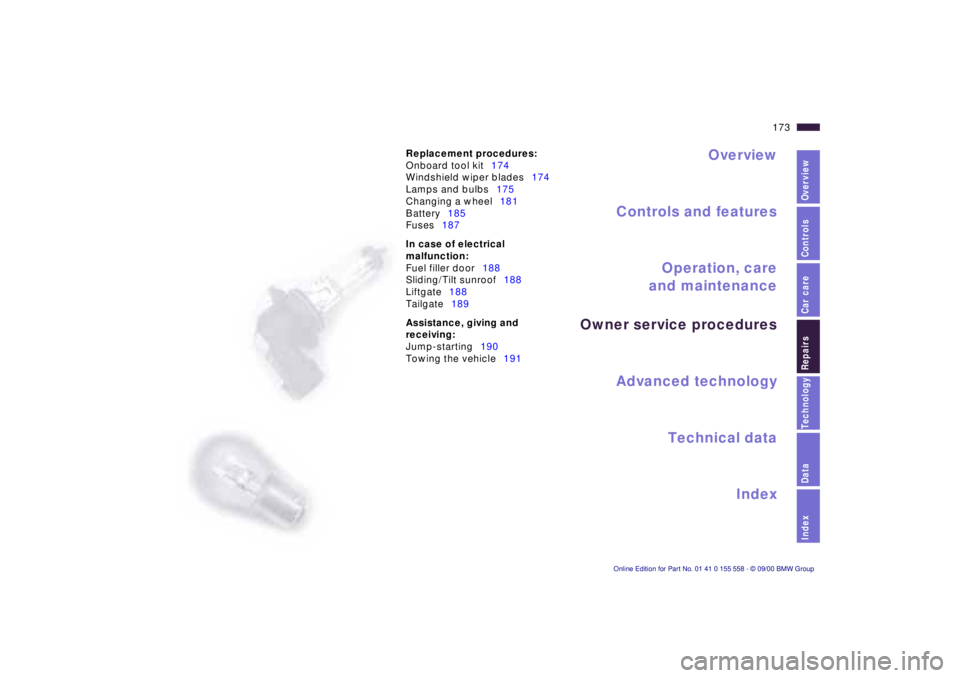
IndexDataTechnologyRepairsCar careControlsOverview
Overview
Controls and features
Operation, care
and maintenance
Owner service procedures
Technical data
Index Advanced technology
173n
Replacement procedures:
Onboard tool kit174
Windshield wiper blades174
Lamps and bulbs175
Changing a wheel181
Battery185
Fuses187
In case of electrical
malfunction:
Fuel filler door188
Sliding/Tilt sunroof188
Liftgate188
Tailgate189
Assistance, giving and
receiving:
Jump-starting190
Towing the vehicle191
Repairs
Page 191 of 223

IndexDataTechnologyRepairsCar careControlsOverview
191n
Jump-starting Towing the vehicle 6 Start the engine on the support
vehicle and let it run.
7 Start the engine on the vehicle
needing the jump-start, and allow it
to run as usual. If the first start
attempt is not successful, wait a few
minutes before another attempt in
order to allow the discharged battery
to recharge.
8 Before disconnecting the jumper
cables from your BMW, turn on the
rear window defroster and set the
blower to the highest speed;
allow the engine to run approx.
10 seconds. This will prevent a
voltage surge from the voltage regu-
lator to the electrical accessories.
9 Then disconnect the jumper cables in
reverse sequence.
Have the battery recharged if neces-
sary.
Tow fitting The screw-in tow fitting is stored
beneath the cargo area floor. Carry it
with you at all times. This fitting is
designed for installation in the tow
sockets located at the front and rear of
the vehicle, and is intended for towing
on paved road surfaces only.
It should not be used to pull a vehicle
out of deep snow, mud, sand, etc.
Always observe all applicable towing
laws and regulations. Access to tow sockets Front:
Use a screwdriver on the left or right
side (arrows) to press the cover out. 530us128
Rear: Pull the cover off.
Screw the tow fittings in until they
are tight. If you do not, the threads
could be damaged.
Do not tow the vehicle by any compo-
nents of the running gear, or lash them
down in any way. If you do so, the
components could be damaged,
leading to possible accidents.<
Use only a nylon towing strap to tow
the vehicle, since the inherent resil-
ience of this material helps protect both
vehicles from sudden jerking move-
ments.
Avoid "off-center" towing. Be sure
that the tow rope is pulled tightly
when the towing vehicle begins to
move.< 530us129
Page 192 of 223
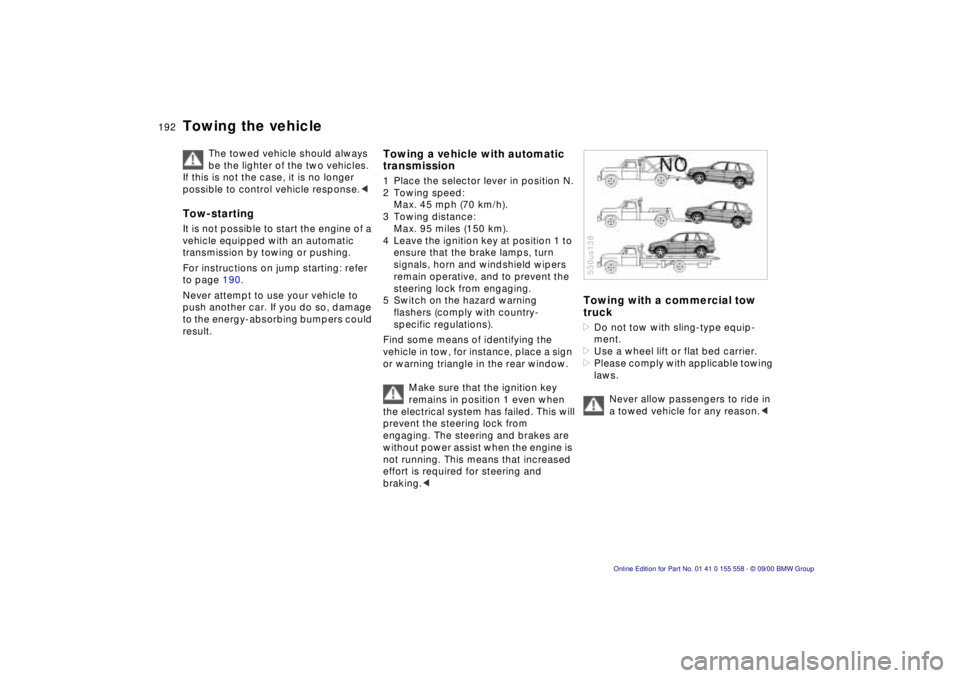
192n
Towing the vehicle
The towed vehicle should always
be the lighter of the two vehicles.
If this is not the case, it is no longer
possible to control vehicle response.<
Tow-starting It is not possible to start the engine of a
vehicle equipped with an automatic
transmission by towing or pushing.
For instructions on jump starting: refer
to page 190.
Never attempt to use your vehicle to
push another car. If you do so, damage
to the energy-absorbing bumpers could
result.
Towing a vehicle with automatic
transmission1 Place the selector lever in position N.
2 Towing speed:
Max. 45 mph (70 km/h).
3 Towing distance:
Max. 95 miles (150 km).
4 Leave the ignition key at position 1 to
ensure that the brake lamps, turn
signals, horn and windshield wipers
remain operative, and to prevent the
steering lock from engaging.
5 Switch on the hazard warning
flashers (comply with country-
specific regulations).
Find some means of identifying the
vehicle in tow, for instance, place a sign
or warning triangle in the rear window.
Make sure that the ignition key
remains in position 1 even when
the electrical system has failed. This will
prevent the steering lock from
engaging. The steering and brakes are
without power assist when the engine is
not running. This means that increased
effort is required for steering and
braking.<
Towing with a commercial tow
truck>Do not tow with sling-type equip-
ment.
>Use a wheel lift or flat bed carrier.
>Please comply with applicable towing
laws.
Never allow passengers to ride in
a towed vehicle for any reason.< 530us138
Page 193 of 223
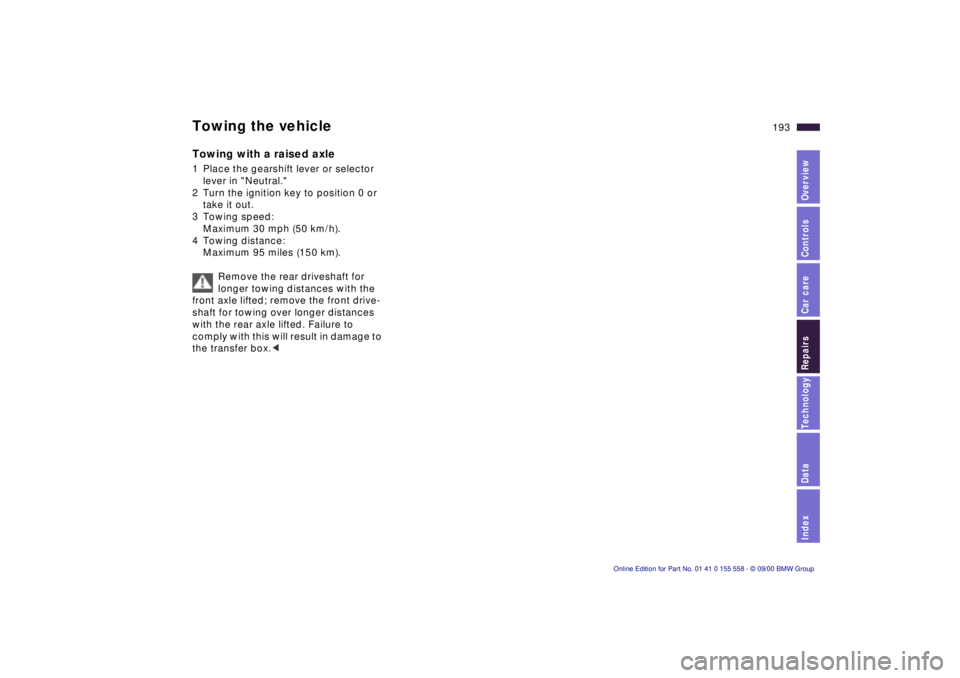
IndexDataTechnologyRepairsCar careControlsOverview
193n
Towing the vehicleTowing with a raised axle1 Place the gearshift lever or selector
lever in "Neutral."
2 Turn the ignition key to position 0 or
take it out.
3 Towing speed:
Maximum 30 mph (50 km/h).
4 Towing distance:
Maximum 95 miles (150 km).
Remove the rear driveshaft for
longer towing distances with the
front axle lifted; remove the front drive-
shaft for towing over longer distances
with the rear axle lifted. Failure to
comply with this will result in damage to
the transfer box.<
Page 216 of 223

Everything from A to Z
E
EBV (Electronic Brake Force Distribution) 138
Electric power windows 45
Electrical malfunction fuel filler door 188t
liftgate 188t
sliding/tilt sunroof 188t
tailgate 189t
Electrical system 210
Electronic Brake Force Distribution (EBV) 138
Electronic immobilizer 35
Elements of operation 16
Emergency operation doors 36t
fuel filler door 188t
liftgate 188t
sliding/tilt sunroof 188t
tailgate 189t
Energy Control 77
Engine 24
Engine compartment 152
Engine coolant 160
Engine oil 157
consumption 157
grades 158
level 24
pressure 22
Engine output 206
Engine specifications 206Error indicators
79
Estimated time of arrival 90
Exterior finish 164
Exterior mirrors 53
Exterior rearview mirrors, automatic dimming
feature 54
F
Failure messages 79t
Failure of an electrical accessory 187t
Filling the windshield washer reservoir 156t
First-aid kit 28
Fittings, tow-starting and towing 191t
Flashlight 118
Flat tire 145, 180 t
Fog lamps 98
bulb replacement 176t
Folding rear backrest 124
Footbrake 140
Footwell lamps 99
bulb replacement 178t
Four-wheel drive 197
Front area lighting 99
Front axle 200
Front fog lamps 98
Front seat adjustment 48Frost protection,
radiator 160
Fuel 30
capacity 209
display 77
gauge 77
quality 30
specifications 30
Fuel consumption 90
average 90
Fuel filler door 29
Fuses 187t
G
Garage-door opener 115
Gasoline 30
General driving notes 136
Glasses compartment 119
Glove compartment 117
bulb replacement 179t
Gross vehicle weight 208
Ground clearance 135
H
Handbrake66
Handsfree system 118
Hazard warning flashers 28
Hazard warning triangle 28
HDC (Hill Descent Control) 95
Head restraints 49Headlamp covers,
care 163t, 175 t
Headlamp flasher 70
Headlamp washer system 156
Headlamp washers 72
Heated seats 112
Heated steering wheel 113
Heating and ventilation 100, 106
Heating while stopped 110
Heating, rapid 105
Heavy cargo 129
Height 207
Height adjustment seats 48
steering wheel 52
HiFi system 199
High beams 25, 98
bulb replacement 175t
High-mount brake lamp 177
Hill Descent Control (HDC) 95
Holder for cans, refer to cup holder 119
Hood release 151t
Horn 26, 27
Hydraulic Brake Assistant refer to DBC 24, 138
Page 220 of 223
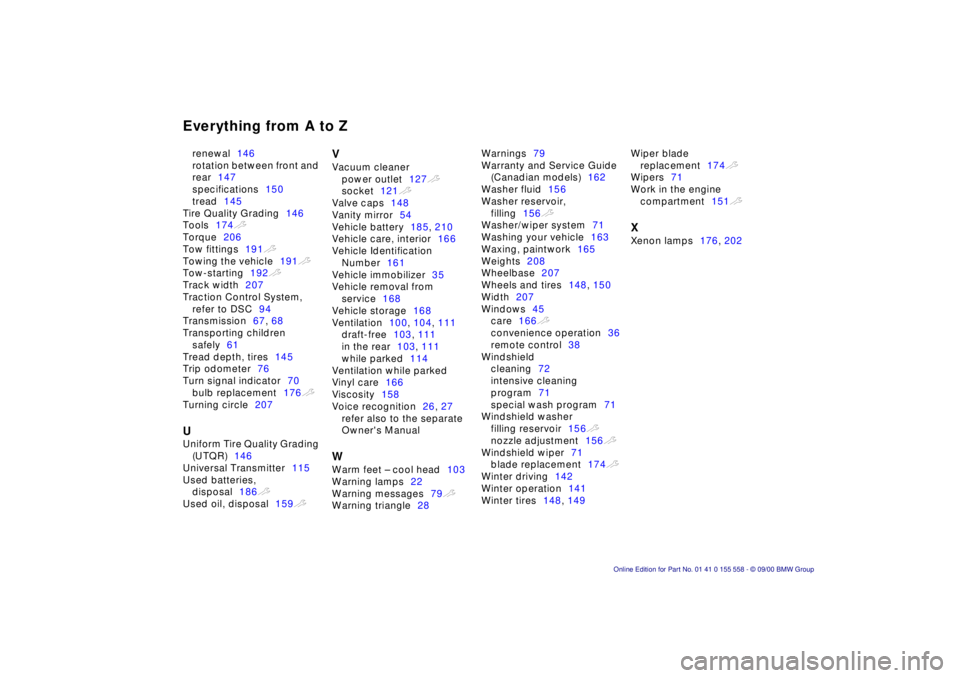
Everything from A to Z
renewal146
rotation between front and
rear 147
specifications 150
tread 145
Tire Quality Grading 146
Tools 174t
Torque 206
Tow fittings 191t
Towing the vehicle 191t
Tow-starting 192t
Track width 207
Traction Control System, refer to DSC 94
Transmission 67, 68
Transporting children safely 61
Tread depth, tires 145
Trip odometer 76
Turn signal indicator 70
bulb replacement 176t
Turning circle 207
U
Uniform Tire Quality Grading
(UTQR) 146
Universal Transmitter 115
Used batteries, disposal 186t
Used oil, disposal 159t
V
Vacuum cleaner
power outlet 127t
socket 121t
Valve caps 148
Vanity mirror 54
Vehicle battery 185, 210
Vehicle care, interior 166
Vehicle Identification Number 161
Vehicle immobilizer 35
Vehicle removal from service 168
Vehicle storage 168
Ventilation 100, 104 , 111
draft-free 103, 111
in the rear 103, 111
while parked 114
Ventilation while parked
Vinyl care 166
Viscosity 158
Voice recognition 26, 27
refer also to the separate
Owner's Manual
W
Warm feet – cool head 103
Warning lamps 22
Warning messages 79t
Warning triangle 28Warnings
79
Warranty and Service Guide (Canadian models) 162
Washer fluid 156
Washer reservoir, filling 156t
Washer/wiper system 71
Washing your vehicle 163
Waxing, paintwork 165
Weights 208
Wheelbase 207
Wheels and tires 148, 150
Width 207
Windows 45
care 166t
convenience operation 36
remote control 38
Windshield cleaning 72
intensive cleaning
program 71
special wash program 71
Windshield washer filling reservoir 156t
nozzle adjustment 156t
Windshield wiper 71
blade replacement 174t
Winter driving 142
Winter operation 141
Winter tires 148, 149 Wiper blade
replacement 174t
Wipers 71
Work in the engine compartment 151t
X
Xenon lamps 176, 202